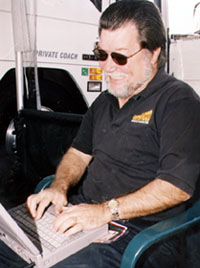| | | |||
 | ||||
|
I'll eat almost anything, but crow has a particularly rancid aftertaste. Nevertheless, it was hard to fault the new NHRA system after the season-opening AutoZone Winternationals at the LA County Fairplex, an event in which there were NO OILDOWNS on race day; an event that was over in time for everyone to enjoy a leisurely dinner and still get to bed early enough to make the first morning flight home. In the modern era which, I suppose, began with Winston's arrival in 1975, no NHRA national event had been completed in less than six hours and eight minutes (for those of you who aren't math majors, that's 5:08 p.m.). Surprisingly, that is alleged to have occurred last year at Houston. By comparison, the 2000 Winternationals was over, done, through, finished at 4:40 p.m. Before the sun even set. It was simple, really. NHRA announced that it would reduce from 90 minutes to 75 the amount of time between professional rounds. Further, it established a fuel restriction (no more than 90 per cent nitromethane in the mix) and imposed a series of fines on those who would litter the racing surface: $500 for every instance during qualifying and $1,000 for each race day incident (plus the loss of lane choice and 10 Winston points). Talk about radical! But, obviously it worked. The first clue should have come during testing at Phoenix and Tucson. Fuel teams at both sites were practicing their 75 minute drills. They still were doing so during qualifying at Pomona. Obviously, the payoff came on Sunday and everyone who has a stake in the sport was a beneficiary. Not that there won't be problems at future events. And not that there won't be adjustments to the system. In fact, there already have been. Originally, teams were to have lost five Winston points each time they caused an oildown during qualifying. That element was waived after discussion. Moreover, an obviously pleased NHRA President Tom Compton acknowledged that the NHRA was not averse to making further adjustments as the season progresses. What a change in attitude! Remember when NHRA was an inflexible bureaucracy? Seems like just yesterday. Hell, it was just yesterday; just last year anyway. There are some hanging points, naturally. There always are in such drastic departures from form. For instance, the 75 minute turnaround places an unwarranted burden on the minimally sponsored or independent teams which cannot afford to hire additional personnel or purchase enough parts to make complete engine swaps a viable between-rounds option. And there's still the question of judgment. How much oil is too much, for instance. But they aren't sticking points. In fact, NHRA has demonstrated a new willingness to listen to the racers and manufacturers and then to act with them to improve the overall product. Compton, working with Executive VP Graham Light and newly hired fuel racing liaison Ray Alley, opted for the current system because it put the onus for improvement on the racers. It didn't impose more rules which must be enforced by an already overtaxed tech department. And it worked! Everyone who played a part can take a bow: NHRA officials, team owners, crew chiefs, crew members. It was a team effort. But, really, it shouldn't have been a surprise. Drag racers have been confounding the odds for 50 years. It's great to know they're still capable of doing so.
Photo by Jeff Burk
| ||||
|
Copyright 1999-2001, Drag Racing Online and Racing Net Source | ||||
 While one race does not a season make, it looks like those who lambasted NHRA for its unconventional plan to reduce the amount of down time to which its spectators are subjected and thereby improve its product for television had better be rapidly acquiring a taste for crow.
While one race does not a season make, it looks like those who lambasted NHRA for its unconventional plan to reduce the amount of down time to which its spectators are subjected and thereby improve its product for television had better be rapidly acquiring a taste for crow.